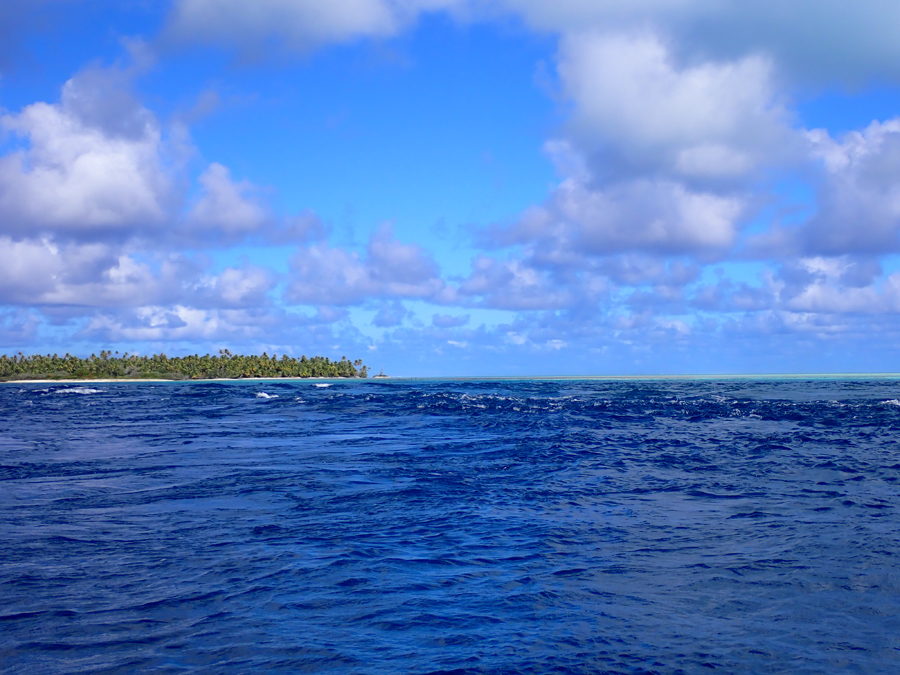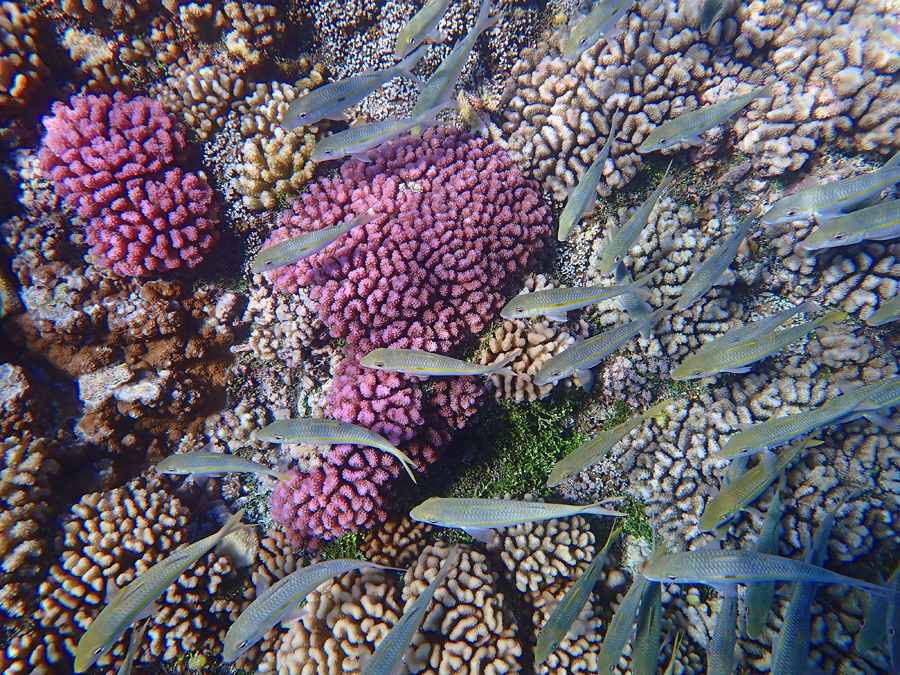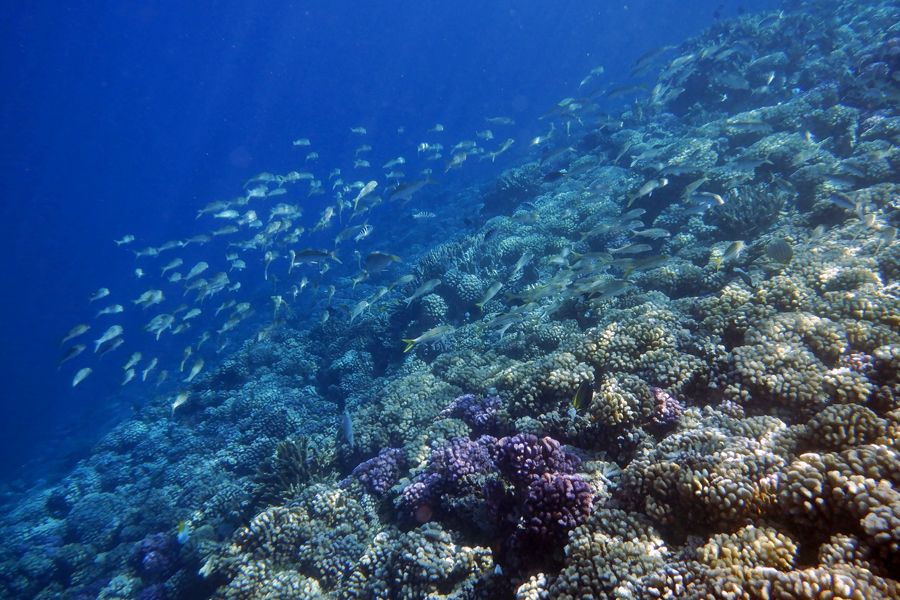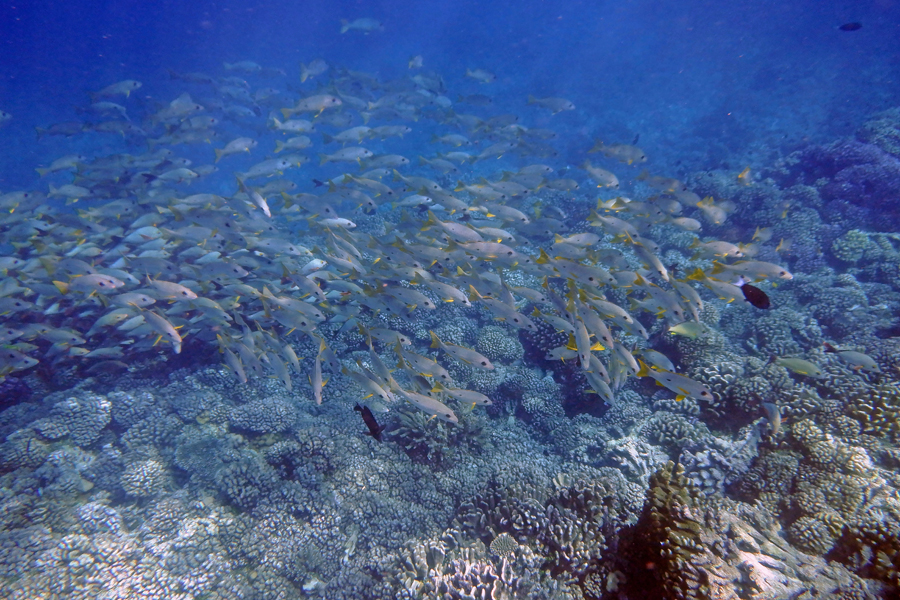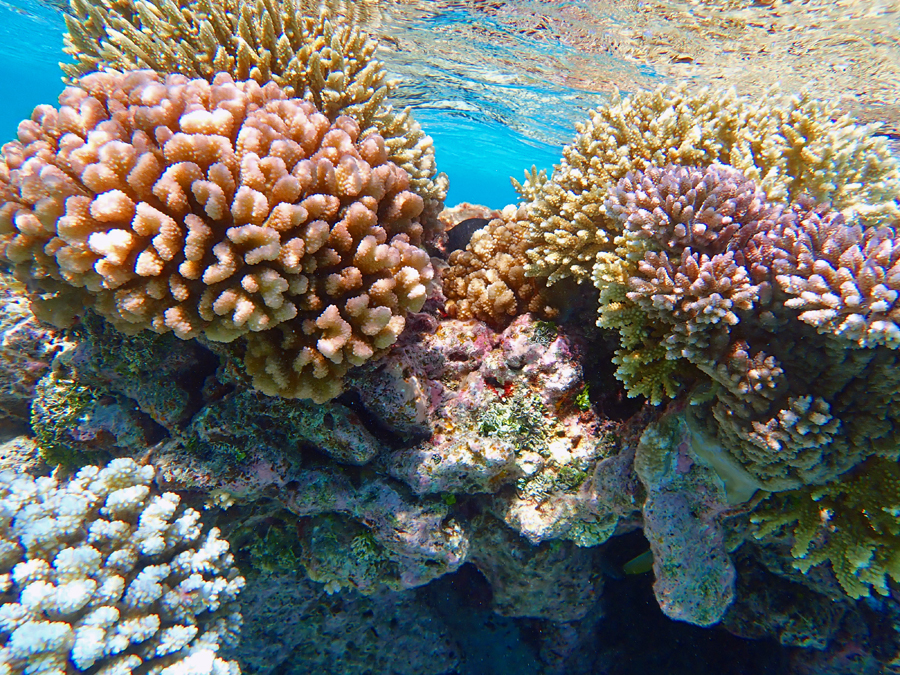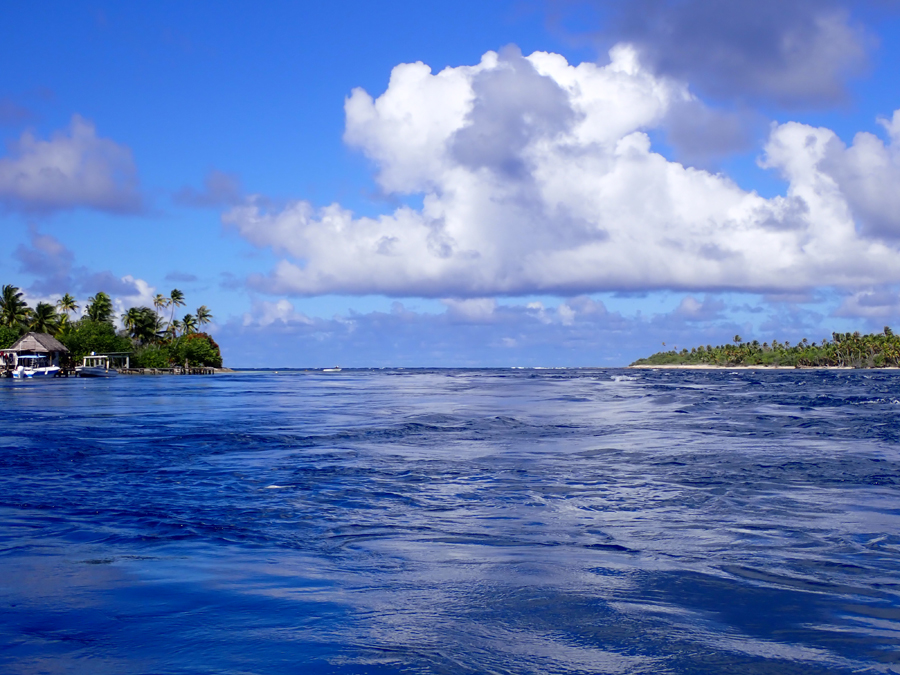
Looking out through Fakarava’s south pass to the South Pacific Ocean. This is a perfectly calm day with no wind. The turmoil you see in the water is caused by very strong currents. Lots and lots of whirlpools and places to be sucked in.
Usually, when a place is hyped by fellow cruisers, it is often a bit of a letdown due to high expectations. This was not the case with Fakarava’s south pass. We have now spent a couple of weeks here on a mooring ball and have had tons of time to explore.
The first thing I should tell you about this pass: the current is wicked. Great care must be taken to swim and dive the pass at slack tide. This happens four times in a 24-hour period. Meaning two opportunities, about an hour each, are presented during daylight hours. If a person is careless about the timing, they can be quickly swept out to sea never to be seen again.
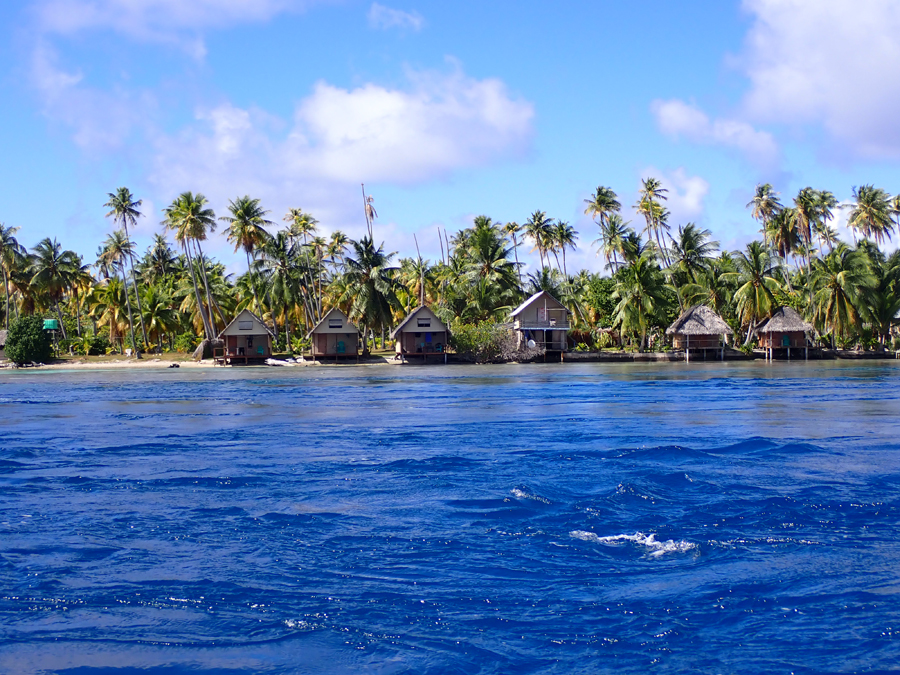
The huts of this pension look inviting to take a swim – perhaps not considering the direction of the current.
When we entered the Fakarava atoll we made a point of using the North Pass. It is wider and the currents have more room to ebb and flow. Care must still be taken in both passes for good reasons but, our judgment in keeping the Puffster safe said to use the North Pass and avoid the South Pass. Our philosophy being why risk it when there is a better alternative about 30 nm away?
Perhaps the safest way we’ve found to explore the pass is to look at what the professional dive boats are doing. We have a tool called the guesstimator. Its name should have warned us. Having the word guess in the title is fitting. It is an Excel workbook put together by another cruiser and widely recommended in the cruising community. It is available on a few blogs and the French Poly FaceBook group page.
I have found this tool to be off. Sometimes by about an hour or more. I am a bit of an Excel guru and have found mistakes in the macros and formulas. When I mentioned this to someone, they responded by telling me I need to learn how to use it. I just smile. Those of you who know my Excel skills are smiling. In our charting software aboard Cream Puff, there is a tide meter for the atoll Tahanea – 50 nm away. I have found this to be much more accurate. No more guessing.
Currents are the reason this area is a world-class diving destination. The current moves nutrients through the pass and this feeds the magnificent coral formations. The coral attracts fish. Small fish attract big fish. And, we saw tons of big fish.
In addition to having lots to see, the water clarity is fantastic. It is easy to see more than 20m (60’). Oftentimes, the clarity is better still. Cream Puff is currently on a mooring in 10m of water (30’) and we can clearly see the atoll floor and all the fish and coral.
There is an event each year when the large camouflage groupers come to the pass to spawn. There are thousands of them. This takes place during a full moon in July. Then, over 700 reef sharks in the area think the grouper are tasty and the feeding frenzy is afoot. Most of this takes place at night. This is one of those unexplained nature events that continues today to baffle scientists as to why the grouper come here.
We watched a documentary about this spawning event prior to arriving here. Some friends gave it to us and we are so very glad they did. In 2014, Laurent Ballesta and his team completed a world record-breaking 24-hour dive in the south pass. He obtained incredible footage providing some of the answers about the mystery beneath the water here. The documentary is called 700 Sharks. If you ever get a chance to watch it, it is incredibly interesting. Not just the shark footage obtained but also the technical challenges the team faces about being underwater for 24 hours straight. There is also a recap of the event in a BBC travel article.
As for us, we didn’t do any night diving to see the sharks attacking the grouper. This is certainly not an appeal for either one of us. We prefer to be in the water during daylight armed with our cameras and basking in the sun to warm up afterward. The waters out here tend to be on the chilly side. We can handle about an hour or perhaps a little longer without a wetsuit or rashguard. However, we certainly saw our share of sharks. Mostly we swam with blacktip sharks. They really don’t have any interest in people. Thank goodness.
If you don’t see the short shark video below, click here.
The shore of this pass is packed with pensions and dive charters. Most of the buildings along the waterfront are pension accommodations. These are not to be confused with luxurious accommodations called over-the-water bungalows you see advertised for ridiculously stupid expensive prices on resort islands, such as Bora Bora, Morea, and Tahiti. These are very basic huts with few amenities. And, they are not cheap. Due to the location, getting everything here is expensive. Due to the fact it has to be unloaded at the north end of the atoll and then transferred by a smaller boat to this remote location. If you are a diehard diver and like to live in moderation, this is the place for you!
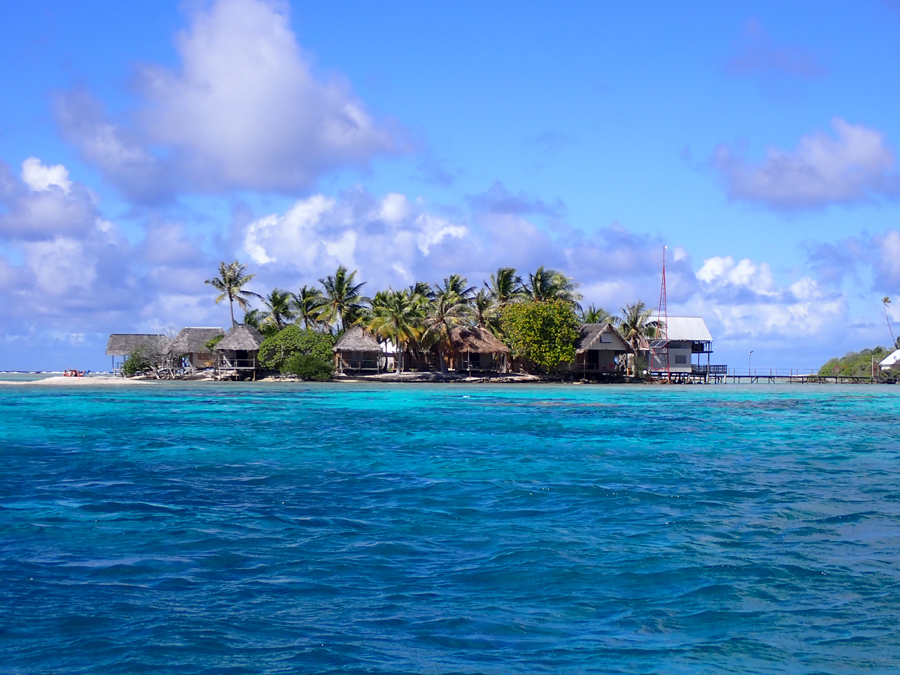
This little motu is a pension on Tetamanu Sauvage. The motu is connected to the mainland of the South Pass, Tetamanu Island by a small foot-bridge (right).
On our first visit to the south pass, we hitched a ride on a boat from a nearby pension (I mentioned this in Part I). We did this to get the lay of the land. The guide showed us the best way to deal with the current, how to stay out of the main channels and where the best places to dock the dinghy when we return later. There is a small inlet marked with two floating buoys. The first buoy is kept on the right side of the dinghy when entering and the second is kept on the left. This marks a dip in the coral just enough to be able to motor through in the dinghy without lifting the outboard motor. Otherwise, the surrounding coral lies just below the surface. In the sheltered area out of the current, there is a small beach. We parked our dinghy out of the way so not to disturb the vacationers or take room from the dive boats.
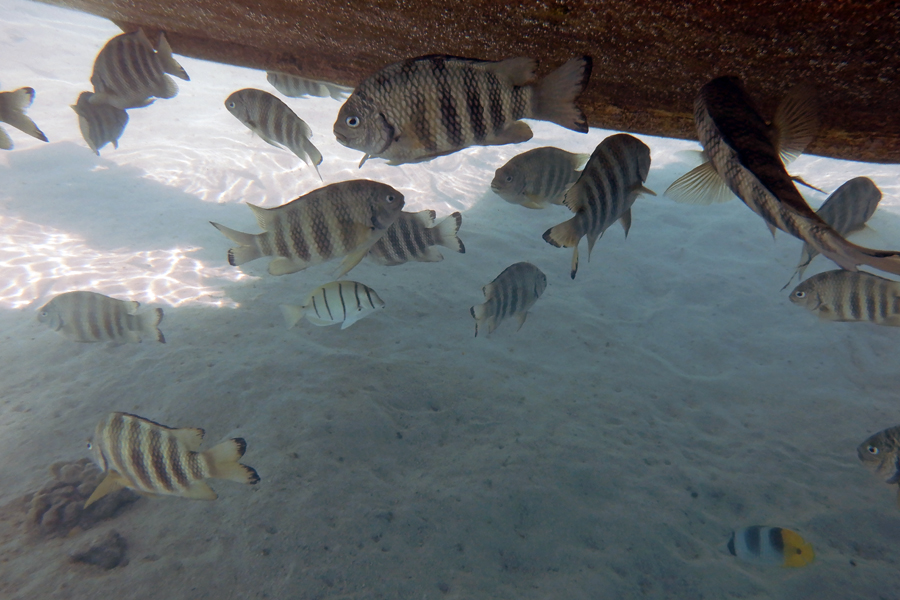
The bottom of the dive boat we were on quickly became a hangout for Sergeant Major fish when it docked.
We were very fortunate to have some friends give us a heads up when a mooring buoy opened at the south pass. While we were enjoying a lazy morning we received a WhatsApp. At the time, we were anchored in a very nice sheltered area of Fakarava near Hirifa but decided to move when we got the text. We figured the buoy was a huge plus but so was being alongside our friends for a few days. In this lifestyle, you grasp these opportunities with eagerness since in a few days we may not know anyone around us.
The south pass is only about an hour away from Hirifa but we needed to take our shade covers down and pulling up our chain floats to get ready for the short jaunt. This means putting things away and securing the boat as well. Although sailing inside the atoll is flat, you never know when you are going to get bounced by a passing boat or a wind gust. Sitting in the cockpit and seeing something fly across the boat below in the cabin isn’t a good thing.
Just before we pulled up the anchor, I noticed a catamaran leaving and heading in the same general direction. Oh no, I thought. Please don’t let them take the only open buoy. The South Pass is a crappy place to anchor and having to deal with it is very unappealing. They were quite ahead of us and there was no way we could beat them there. I am wondering if this is the price we pay for being a couple of slowpokes leaving Hirifa. And right about this time, we get another message from our friends saying the cat decided to anchor and the mooring is still open – we are the only boat on the horizon.
Some boaters do not trust moorings. This is especially true when there is a wrecked boat on the shore that was once tethered to a mooring during some bad weather. One of the cruising guides we follow (the same one with outdated information on fueling options in Fakarava) warned cruisers not to use the buoys as there are considered unsound. This is hogwash!
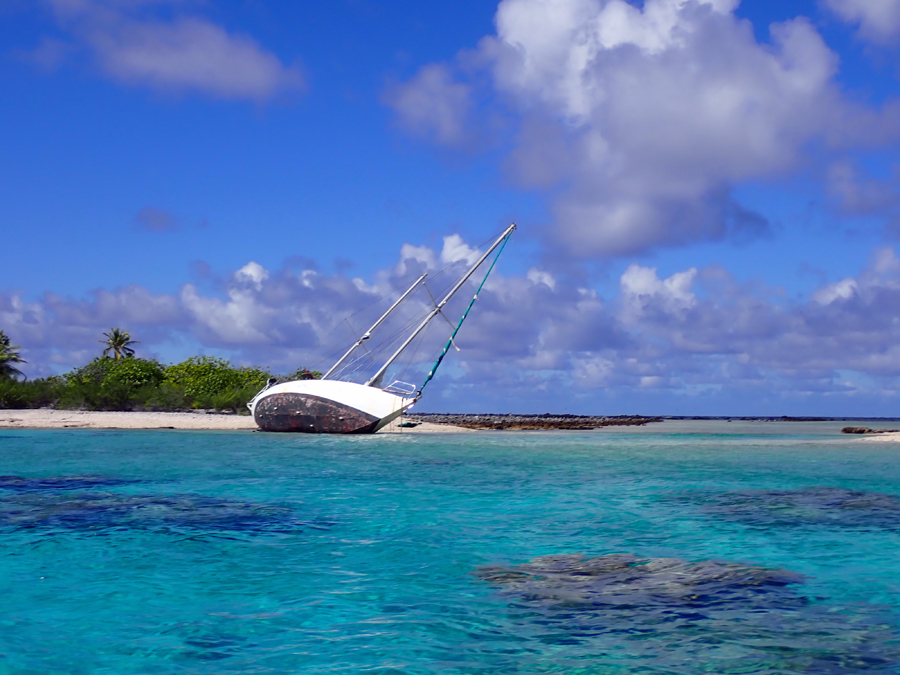
The very sad result of a boater who decided to stay on a mooring during bad weather rather than anchor in a safer location
I took time to inspect the buoy. The chain was still shiny and had very little rust. The swivel showed no signs of stress. The screw at the base was still deeply buried in the sand. The rope was in like new condition and had no chafing. It was quite obvious to me the mooring was well maintained and had recently been serviced. In this area, I would take a mooring every time before dropping an anchor here. Why you ask?
The bottom is littered with coral heads. Some are 10-meter tall pillars rising up from the floor of the atoll. There is very little sand for the anchor to dig in. The chances of hitting the sand with the anchor and being able to let out enough chain to satisfy the correct chain:depth ratio is slim to none. And, when the boat swings about with the shifting wind and currents, the chances drastically increase that the chain may become wrapped around more than one coral head. This makes retrieving the anchor an absolute nightmare.
There are only 6 mooring buoys. Some boats have no other choice but to anchor. During our time on the buoy, we watch too many boats to count have trouble getting the anchor up when they decided to depart. One poor guy was seriously wrapped. He tried for what seemed like an eternity trying to pull up his anchor from various different directions. Lucky for him he was a diver and had equipment. It took him about 30 minutes under the water to sort out the chain.
Most of the boats don’t use any method of floating the chain. If they do, the attempt is feeble using just a couple of boat fenders. The correct use of this technique can really help keep the anchor chain off the coral heads. For me, the saddest part of watching the boaters participate in these chain retrieval antics is knowing below the surface the coral heads are being destroyed. These have taken eons to grow and are the habitat for many species of fish.
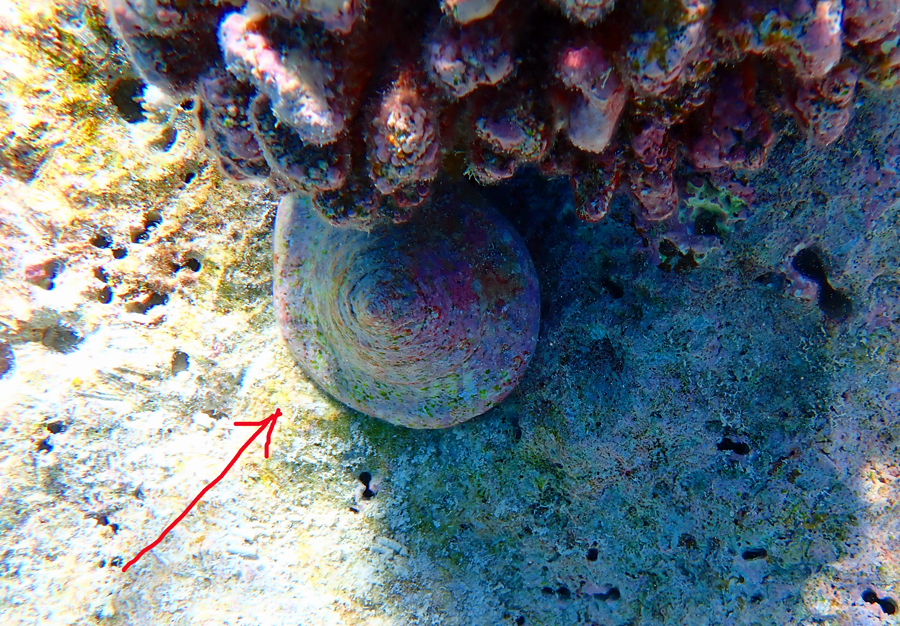
This is the first time we’ve seen one of these – yes – it has a critter living in it – Trochus Niloticus
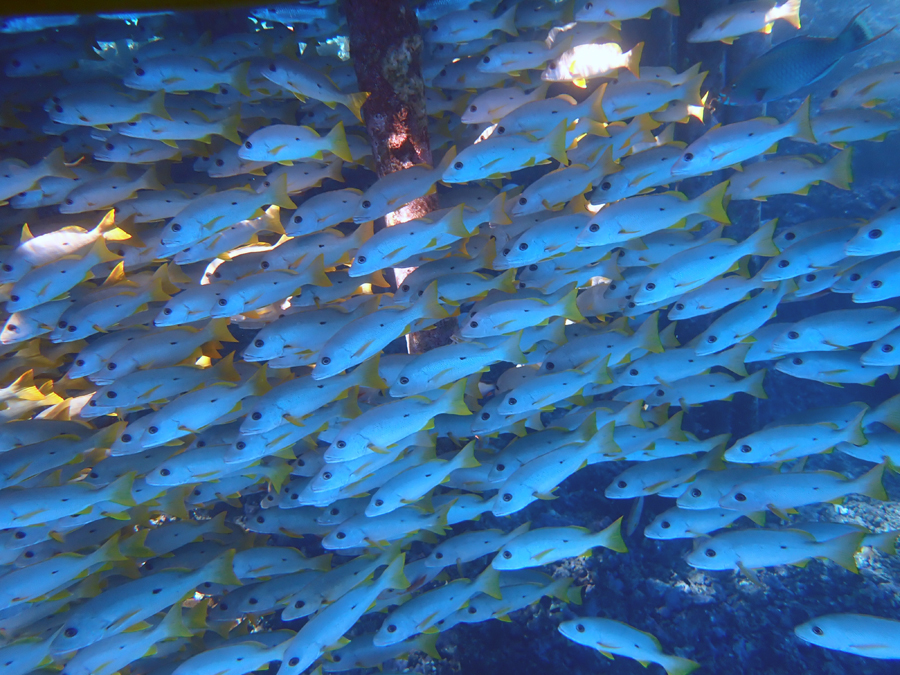
Unlike these fish under a dive boat dock, we prefer to have a little bit of space around us when we are hanging out
Our mooring was located at the end of a group of four. We had a constant struggle with waving people off who intended to anchor too close. A boat on a mooring and a boat on anchor have different arc sizes in they swing as the wind changes. It seems a few other boaters either don’t know this or don’t care. Then a boat, we’ll call it Boat A (I don’t care to publically shame people), anchored very close to our starboard side while we were away having fun. I politely asked them if they’d move since the winds that night were due to increase and blow from another direction. They ignored the request.
Boat A was also positioned directly over the anchor of another boat once they settled and extended the chain reach. This would make it difficult for the other boat behind them to leave or reposition themselves should anything happen during a weather change. Why they did this is beyond me. There was a ton of open space in the anchorage and I can’t imagine any reason other than disrespect or self-centeredness for anchoring where they did.
In an instance like this, we take a couple of pictures. Should they hit us and cause damage, we have documentation about where and how they are anchored for our claim against their insurance company. Should they do a hit and run, we have the name of their vessel on file.
The next day we were treated to the noise of their on-deck dive compressor for hours on end. It should be noted, they positioned the compressor on the bow to minimize noise for themselves but obviously didn’t care about the people around them having to listen to it.
I need to say here, this anchor cuddling is not normal. We’ve experienced it only a few times in our world travels. Most other sailors will respect the space around another sailor’s boat. It is not just about the possibility of bumping boats. It is also about giving neighbors some privacy. We have been in anchorages with limited space and always make a point of asking our new neighbors if they are okay with our position. If they aren’t we can easily move without issue. But oftentimes, we wind up chatting and making new friends.
Boat A consisted of a family with two young kids. There were friends with Boat B on a mooring next to us on the port side. Boat B was also a family with young kids. The guy on Boat B had no issue with standing on the rear of his vessel and whipping out his penis for all to see while he urinated off the back of the boat. In such close proximity, it was hard not to see. This was a frequent event. It’s time to move.
One of the great things about this lifestyle is when faced with disrespectful neighbors, we can move. As I see things, there are a couple of choices. We can duke it out with our neighbors and point out their annoyances. No doubt this wouldn’t end well and I seriously doubt if I could get them to understand how their behavior was irritating. We could try to ignore them and hope they leave. But, to be honest, it is hard to ignore a man exposing himself in one direction while we have a loud pneumatic noise in the opposite direction. Or, we can just move on and go to a better place.
We were ready to leave the south pass anyway. We’d seen all there is to see. It only takes us about an hour to prep Cream Puff for a sail back to Rotoava as we need a few grocery items. We enjoy a wonderful sail back up to the town and anchor in exactly the same spot where we were a month ago. In town, we pick up a few needed items in the store, drop off our trash and receive some great news.
A friend of ours, back in Tahiti, has scored some tickets for the finals of the Heiva dancing contest in about 4 weeks and asked us if we want to go with them. Having already attended Heiva dance competition the previous year, we absolutely loved it. And, this is for the finals! Our answer is a resounding and empathic yes. We had planned to be back in that area soon after the event so we had no issue leaving a little earlier. As we start to look at some weather windows, we see a couple of big systems building off New Zealand. It looks like if we dilly dally we might get stuck in Fakarava for a few days. So we decide to make our way back to Tahiti, sooner than planned. We’ve been in Fakarava for 3 months.
I just recently read an article about Fakarava that stated the atoll plans to install more moorings for boats. They are looking at an anchoring ban and limiting the number of boats in the atoll. I have to say, I am 100% for this. Watching boats destroy coral with their anchor chain is heartbreaking knowing how the world’s reefs are struggling. Also, watching cruisers swarm the few stores after the supply ships arrive gobbling up the perishable foods has no doubt put some animosity and tension between the locals directed toward the visiting sailors. Not everybody is respectful of where they leave their dinghies when going ashore even though the township has provided a great place to dock them. I would imagine the local government is reacting to the resident’s complaints. Who can blame them? If the shoe was on the other foot, I think the cruisers would be complaining about the same things.
We noticed the local people in Fakarava were a little bit stand-offish. After an attempt by us to say hello or wish them a good day, they did eventually warm up and smiles appeared. We both commented to each other about a little bit of tension in the air. Some friends from Scotland also mentioned to us they felt the same thing. Don’t get me wrong, the people aren’t rude. This is certainly not the case at all. But, there is something there. And now, after reading this article about people being upset by the number of boats, I think I understand.

